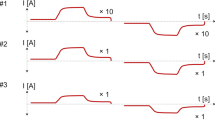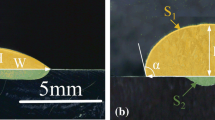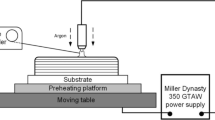Abstract
A cold metal transfer pulse advance (CMT-PA) arc mode was employed in this paper for the wire arc additive manufacturing of Al alloy. The effects of process parameters on deposition surface morphologies and geometrical characteristics were investigated. And a deposition width model was built by the multiple linear regressions. Based on the principle that the volume of the sample is equal to that of filler wire, a deposition height model was simultaneously derived. The results indicate that the disparity between two trends of droplet spreading in horizontal and molten pool tangential direction determines directly the final deposition geometrical characteristics. And two trends would be mainly affected by the heat input and arc force closely related to process parameters. The influences of three factors on the effective width percentage show a trend of first increasing and then decreasing. So, it provides an optimal process window for good deposition forming. The effective width percentage reaches 83% and the machining allowance is only 0.71 mm, which significantly improves material utilization and reduces manufacturing costs. Besides, the error rates of deposition width and height models are less than 4% and 6%, respectively. Two models can facilitate fabricating different size complex parts and make a profit for the actual production.












Similar content being viewed by others
References
Wu B, Pan Z, Ding D, Cuiuri D, Li H, Xu J, Norrish J (2018) A review of the wire arc additive manufacturing of metals: properties, defects and quality improvement. J Manuf Process 35:127–139
Wang F, Williams SW, Colegrove P, Antonysamy A (2013) Microstructure and mechanical properties of wire and arc additive manufactured Ti-6Al-4V. Metall Mater Trans A 44(2):968–977
Aiyiti W, Zhao W, Lu B (2006) Investigation of the overlapping parameters of MPAW-based rapid prototyping. Rapid Prototyping J 12(3):165–172
Liu L, Zhuang Z, Liu F, Zhu M (2013) Additive manufacturing of steel-bronze bimetal by shaped metal deposition: interface characteristics and tensile properties. Int J Adv Manuf Technol 69:2131–2137
Xiong J, Zhang G (2014) Adaptive control of deposited height in GMA-based layer additive manufacturing. J Mater Process Technol 214:962–968
DebRoy T, Wei HL, Zuback JS, Mukherjee T, Elmer JW, Milewski JO, Beese AM, Wilson-Heid A, De A, Zhang W (2018) Additive manufacturing of metallic components-process, structure and properties. Prog Mater Sci 92:112–224
Ding D, Pan Z, Cuiuri D, Li H (2015) Wire-feed additive manufacturing of metal components: technologies, developments and future interests. Int J Adv Manuf Technol 81:465–481
Fang X, Ren C, Zhang L, Wang C, Huang K, Lu B (2021) A model of bead size based on the dynamic response of CMT-based wire and arc additive manufacturing process parameters. Rapid Prototyping J 27(4):741–753
Cong B, Qi Z, Qi B, Sun H, Zhao G, Ding J (2017) A comparative study of additively manufactured thin wall and block structure with Al-6.3%Cu alloy using cold metal transfer process. Appl Sci-Basel 7(3):275
Wang H, Jiang W, Ouyang J, Kovacevic R (2004) Rapid prototyping of 4043 Al-alloy parts by VP-GTAW. J Mater Process Technol 148(1):93–102
Williams JC, Starke EA (2003) Progress in structural materials for aerospace systems. Acta Mater 51(19):5775–5799
Wang J, Feng J, Wang Y (2008) Microstructure of Al-Mg dissimilar weld made by cold metal transfer MIG welding. Mater Sci Tech 24(7):827–831
Pickin CG, Young K (2006) Evaluation of cold metal transfer (CMT) process for welding aluminium alloy. Sci Tech Weld Join 11(5):583–585
Zhang H, Feng J, He P (2007) Interfacial phenomena of cold metal transfer (CMT) welding of zinc coated steel and wrought aluminium. Mater Sci Tech 24(11):1346–1349
Pickin C, Williams SW, Lunt M (2011) Characterisation of the cold metal transfer (CMT) process and its applications for low dilution cladding. J Mater Process Technol 211(3):496–502
Clark D, Bache MR, Whittaker MT (2008) Shaped metal deposition of a nickel alloy for aero engine applications. J Mater Process Technol 203(1–3):439–448
Williams SW, Martina F, Addison AC, Ding J, Pardal G, Colegrove P (2016) Wire+arc additive manufacturing. Mater Sci Technol 32:641–647
Pan Z, Ding D, Wu B, Cuiuri D, Li H, Norrish J (2018) Arc welding processes for additive manufacturing: a review. Trans Intell Weld Manuf 3:3–24
Jiang Y (2013) Research on the rapid prototyping technology and forming process of aluminum alloy based on the CMT. Dissertation, Harbin Inst Technol, Harbin
Cong B, Ding J, Williams SW (2015) Effect of arc mode in cold metal transfer process on porosity of additively manufactured Al-6.3%Cu alloy. Int J Adv Manuf Technol 76(9–12):1593–1606
Zhang C, Li Y, Gao M (2018) Wire arc additive manufacturing of Al-6Mg alloy using variable polarity cold metal transfer arc as power source. Mater Sci Eng A 711:415–423
Azar AS (2015) A heat source model for cold metal transfer (CMT) welding. J Therm Anal Calorim 122(2):741–746
Liu S, Zhang F, Dong S, Zhang H, Liu F (2018) Characteristics analysis of droplet transfer in laser-MAG hybrid welding process. Int J Heat Mass Tran 121:805–811
Gao X, Wu C, Goecke S, Kügler H (2017) Numerical simulation of temperature field, fluid flow and weld bead formation in oscillating single mode laser-GMA hybrid welding. J Mater Process Technol 242:147–159
Huang H (2018) Study on droplet transfer of CMT+P welding process in SAF2507 super duplex stainless steel. Dissertation, Tianjin University, Tianjin
Liu X (2014) Mechanical analysis on arc plasma and droplet during short-circuit CO2 welding controlled by external magnetic fileds. Dissertation, Shenyang Univ Technol, Shenyang
Li K, Wu C (2009) Mechanism of metal transfer in DE-GMAW. J Mater Sci Technol 25(3):415–418
Li J (2018) Study on metal transfer behavior and welding formation of 6061 aluminum alloy variable polarity CMT and CMT+P. Dissertation, Tianjin University, Tianjin
Funding
This research is financially supported by the National Natural Science Foundation of China (grant nos. 51775206) and the foundation of the National Key Laboratory for Remanufacturing (No. 6142005200401).
Author information
Authors and Affiliations
Contributions
Yazhou Zhang designed and conducted the experiments, organized all the data, and wrote the manuscript. Ming Gao evaluated the obtained data and supervised all research. Yang Lu and Wenbo Du completed the auxiliary data analysis work. All authors read and approved the final manuscript.
Corresponding author
Ethics declarations
Competing interests
The authors declare no competing interests.
Additional information
Publisher's note
Springer Nature remains neutral with regard to jurisdictional claims in published maps and institutional affiliations.
Highlights
• The influential mechanisms of process parameters on the deposition geometrical characteristics are analyzed. Process parameters can affect the trends of droplet spreading in the horizontal direction and molten pool tangential direction. The disparity between the two trends determines the final deposition morphology.
• This paper studies the influence of process parameters on the effective width percentage and provides a process window of good deposition forming, which can improve materials utilization and reduce manufacturing costs.
• Effective deposition width and height models are established for the convenience of manufacturing different size parts in the actual production.
Rights and permissions
Springer Nature or its licensor (e.g. a society or other partner) holds exclusive rights to this article under a publishing agreement with the author(s) or other rightsholder(s); author self-archiving of the accepted manuscript version of this article is solely governed by the terms of such publishing agreement and applicable law.
About this article
Cite this article
Zhang, Y., Gao, M., Lu, Y. et al. Deposition geometrical characteristics of wire arc additive-manufactured AA2219 aluminium alloy with cold metal transfer pulse advance arc mode. Int J Adv Manuf Technol 123, 3807–3818 (2022). https://doi.org/10.1007/s00170-022-10460-4
Received:
Accepted:
Published:
Issue Date:
DOI: https://doi.org/10.1007/s00170-022-10460-4




